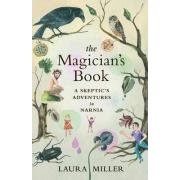BOOK REVIEW
The Magician’s Book: A Skeptic’s Adventures in Narnia by Laura Miller
Little Brown: 320 pp., $25.99
By Nan Rinella
To anyone who loves C.S. Lewis and Narnia, The Magician’s Book presents a dichotomy between delight and disbelief. The critique/biography/author’s memoir is mesmerizing in its perspicacity, but mystifying from a Christian perspective.
Laura Miller is a literary critic who was raised a Catholic in the California desert and studied literature at the University of California at Berkeley. She is a cofounder of Salon.com and a contributor to the New York Times Book Review. She writes, “The process of writing about a book can reveal things you’d never get from simply reading it.” I can certainly relate, because reading Miller’s book and writing this review has been a labor of love to this student of C. S. Lewis and J. R. R. Tolkien, and an extraordinary journey that led to a surprising and startling discovery.
She admits that her rocky love affair with Narnia is one of enchantment, betrayal, estrangement, and reunion. For a long time after discovering the Christian overtones, Miller blocked out Narnia, but she could not help but eventually return, coming to terms with it. She claims, “What I dislike about Narnia no longer eclipses what I love about it.” But for all the countless times she has reread the books, they have never succeeded in converting her. She confesses though, that The Lion, the Witch and the Wardrobe will always be the best book she’s ever read because of how it made her feel. She admits, “If any books could have persuaded me, it would have been these, yet I didn’t budge.”
The title of The Magician’s Book comes not from The Magician’s Nephew, a tale of two children thrown into the birth of Narnia, but from the magician’s book that Lucy peeks in to find out its secrets in The Voyage of the Dawn Treader. Miller’s literary criticism begins with the memories of the author as a child of nine who “opened the hinged cover of a book”-like Lucy opening the door to the wardrobe-and stepped through it into another world. “Narnia,” she writes, “seemed to emerge, by some miracle, out of my unspoken self.” She told the teacher who gave her The Lion, the Witch and the Wardrobe, that she didn’t know that there were other people who had the kind of imagination that she did. And she wanted more, but was afraid to talk about it lest it go away.
In Miller’s opinion, “the made-up-ness of Narnia has always seemed particularly glaring to certain well-read adults who never encountered the books as children.” Not this adult. But then, I’m the grownup, who at age forty, cried when Christopher Robin said good-by to Winnie the Pooh, as I read The House at Pooh Corner to my two-year-old son.
As a reader who first visited all of Aslan’s magical land at sixty, I was enthralled with Miller’s childhood recollections. Because I missed that blissful thrill of reading these adventures as an innocent, I relished experiencing it second-hand. I enjoyed her exploration of the influence that first books have on children, and was intrigued by her supposition that the books we’ve loved best are seldom the ones we esteem the most highly.
